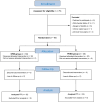Comparison of Analgesic Efficacy between Ultrasound-guided Supra-inguinal Fascia Iliaca Block and Pericapsular Nerve Group Block following Total Hip Arthroplasty: A Randomized Controlled Trial
- PMID: 39620570
- PMCID: PMC11638753
- DOI: 10.5371/hp.2024.36.4.290
Comparison of Analgesic Efficacy between Ultrasound-guided Supra-inguinal Fascia Iliaca Block and Pericapsular Nerve Group Block following Total Hip Arthroplasty: A Randomized Controlled Trial
Abstract
Purpose: The effectiveness of pericapsular nerve group (PENG) block versus suprainguinal fascia iliaca block (SFIB) for pain relief after hip arthroplasty is a topic of ongoing debate. This study aimed to examine the association of PENG block with lower consumption of opioids during the first 24 hours following surgery compared to SFIB.
Materials and methods: In this single-center, double-blind, randomized controlled trial, 60 patients scheduled for an elective posterior approach to total hip arthroplasty (THA) were randomized according to two groups: ultrasound-guided PENG block (PENG group) or SFIB (SFIB group). The 24-hour consumption of intravenous fentanyl was the primary outcome. Secondary outcomes included perioperative consumption of intravenous fentanyl, pain scores, sensorimotor function, and functional measures.
Results: No significant intergroup difference was observed in 24-hour total fentanyl consumption (SFIB group: 117.4±99.8 μg, PENG group: 145.9±122.7 μg; mean difference: 22.6 μg [95% confidence interval -36.6 to 81.8]; P=0.45). No statistically significant difference in terms of fentanyl consumption in intraoperative, post-anesthetic care unit, at 6-hour and 48-hour postoperatively was observed between the two groups. No statistically significant differences in scores for rest and dynamic pain for all aspects of hip joint and surgical incision were observed between the groups (P>0.05). Better cutaneous sensory perception in the hip region and 12-hour postoperative quadriceps muscle strength at 90° were observed in the PENG group compared with the SFIB group (P<0.05).
Conclusion: Compared to SFIB, the addition of PENG block to multimodal analgesia did not reduce fentanyl consumption or pain scores after posterior approach THA.
Keywords: Nerve blockades; Peripheral nerves; Postoperative pain; Total hip arthroplasty; Ultrasound.
Conflict of interest statement
No potential conflict of interest relevant to this article was reported.
Figures


References
-
- Frassanito L, Vergari A, Nestorini R, et al. Enhanced recovery after surgery (ERAS) in hip and knee replacement surgery: description of a multidisciplinary program to improve management of the patients undergoing major orthopedic surgery. Musculoskelet Surg. 2020;104:87–92. doi: 10.1007/s12306-019-00603-4. https://doi.org/10.1007/s12306-019-00603-4. - DOI - PubMed
-
- Choi YS, Kim TW, Chang MJ, Kang SB, Chang CB. Enhanced recovery after surgery for major orthopedic surgery: a narrative review. Knee Surg Relat Res. 2022;34:8. doi: 10.1186/s43019-022-00137-3. https://doi.org/10.1186/s43019-022-00137-3. - DOI - PMC - PubMed
-
- Soffin EM, Wu CL. Regional and multimodal analgesia to reduce opioid use after total joint arthroplasty: a narrative review. HSS J. 2019;15:57–65. doi: 10.1007/s11420-018-9652-2. https://doi.org/10.1007/s11420-018-9652-2. - DOI - PMC - PubMed
-
- Højer Karlsen AP, Geisler A, Petersen PL, Mathiesen O, Dahl JB. Postoperative pain treatment after total hip arthroplasty: a systematic review. Pain. 2015;156:8–30. doi: 10.1016/j.pain.0000000000000003. https://doi.org/10.1016/j.pain.0000000000000003. - DOI - PubMed
-
- Gerhardt M, Johnson K, Atkinson R, et al. Characterisation and classification of the neural anatomy in the human hip joint. Hip Int. 2012;22:75–81. doi: 10.5301/HIP.2012.9042. https://doi.org/10.5301/HIP.2012.9042. - DOI - PubMed
LinkOut - more resources
Full Text Sources

